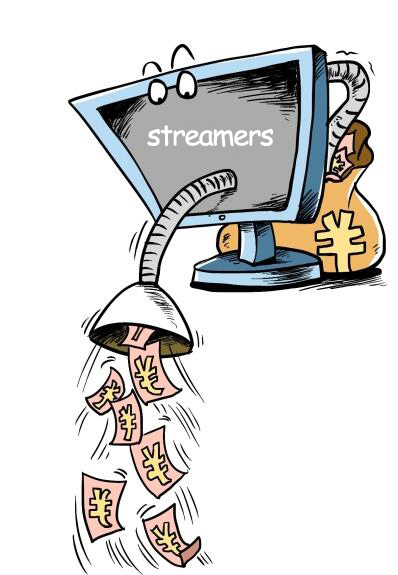Growing individual youth consciousness promotes domestic live streaming sector

The fundamental difference of streamers from traditional anchors lies in their craze for economic benefits while paying little attention to social values. Governments need to make full use of their influence and help streamers guide values of fans in the right direction.
Live streaming serves as an important channel through which the post-90s generation communicates and learns. Beijing is home to more than 100 live streaming platforms and 76,000 full-time streamers, 62.1 percent of which joined the sector in 2016 and less than 10 percent in 2014, demonstrating a sharp increase in streamers annually. Most streamers and over 60 percent of their viewership were born in the 1990s, according to the investigation.
Online streamers differ from traditional media reporters. They can broadcast their lives anywhere with computers or smartphones. Their displays of talent or distinctive characteristics attract viewers without constraints on oral expression, facial appearance or professional performance. Ordinary people rather than entertainment stars and online celebrities are more likely to become streamers. The content of live streaming varies and it often pertains to daily life.
Youth engaging in artistic professions dominate the sector, including independent actors and singers, street artists as well as self-employed painters and photographers. They account for 38.7 percent of the group while those who specialize in management and economics each make up 12.2 percent and 9.1 percent respectively. Fewer streamers were involved in the studies of literature, engineering and education. The large number of artists matches professional demands for anchors while revealing the supply-demand relations in the live streaming industry.
Geographically, about 15 percent of streamers come from urban areas, such as provincial capitals and municipalities, while another 17 percent live in prefecture-level cities. Streamers from counties, townships and villages collectively account for 55 percent. Therefore, live streaming industry, to some extent, creates opportunities for youth and young adults of nonprofessional background to fulfill individual development and make their dreams a reality.
The majority of streamers are ordinary young people who present themselves in the screen showrooms and feel recognized. Striving for constant improvement, some online stars even change their destiny and achieve personal values in this process. The demand for streaming shows the desire of today’s youth to build an inner world and voice their ideas, meaning the awakening of individual consciousness has entered a new stage in China’s modernization process.
The emergence of streamers parallels the development of individualization in China. Individualist values shave enlightened the youth while wireless internet technology increases the effect. Live streaming allows young people today to engage in social communication in a virtual environment in which they express individual desires and lifelong commitment in public. The new online space created by young people is less costy, more convenient and more straightforward.
The emerging industry enables an ideal relationship among strangers. In a society with great mobility and openness, most interaction takes place among strangers. Without the risk of being embarrassed, screen showrooms offer young people from many social backgrounds the opportunity to pursue connections with strangers and help them find the right positions.
Live streaming solicits a massive crowd of youth in a short time for its success in meeting their media habits and wishes to be respected and recognized, leading to a crowd carnival on the internet. Deep interpersonal circles will take shape because the activity allows young people various social compositions to exchange views and reach consensus.
Speaking in terms of content, people and events are two central factors. Some streamers consider the streaming platforms their showrooms where they tell jokes, present their talents, chat with fans or broadcast their daily lives. Other streamers are devoted to news dissemination. Like media reporters, they go to different sites and aim their lens at a series of events. However, all the content is a mixture of facial beauty, talent and emotion.
In the survey, people are allowed to select multiple answers on one question. The result shows that broadcasts about entertainment talent tend to dominate live streaming platforms, accounting for about 47 percent of the entire sector while companionship and daily living skills and chatting account for about 38 percent and 22 percent respectively.
Such content reflects a collective expression and supply of emotion. In terms of motivation, the investigation found that about 40 percent of viewership want to enliven their boring lives and appreciate talent shows through watching live streaming content. Around 37 percent of streaming app users intend to tackle pressure while 18 percent aim to learn skills and knowledge. From the perspective of streamers, about half of them hold that live streaming can pacify pressure of fans. and 34 percent of them help fans kill time. Also, about one-fourth of the streamers suggest that online shows can reduce the loneliness of the viewers and cheer them up, thus relieving social tensions.
The article was translated from Guangming Daily.
